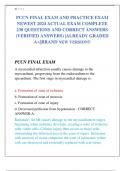1|Page
PCCN FINAL EXAM AND PRACTICE EXAM
NEWEST 2024 ACTUAL EXAM COMPLETE
230 QUESTIONS AND CORRECT ANSWERS
(VERIFIED ANSWERS) |ALREADY GRADED
A+||BRAND NEW VERSION!!
PCCN FINAL EXAM
A myocardial infarction usually causes damage to the
myocardium, progressing from the endocardium to the
epicardium. The first stage in myocardial damage is:
a. Formation of zone of ischemia
b. Formation of zone of necrosis
c. Formation of zone of injury
d. Decreased perfusion from hypotension - CORRECT
ANSWER-A:
Rationale: An MI causes damage to the myocardium in stages
beginning when ischemia develops, creating a zone of ischemia
with viable cells. Cellular injury then occurs to those cells
surrounding the infarcted area in the zone of injury. Infarction
with necrosis of tissue comprises the zone of infarction, where
cells are destroyed and eventually replaced with scar tissue.
,2|Page
People may exhibit either hypertension or hypotension during an
MI.
A patient presents with pulmonary edema characterized by
tachypnea, tachycardia, hypertension, cough, fever, and cough
with frothy sanguineous sputum. What initial treatments are
most common?
a. Oxygen, nitroglycerine, loop diuretics (furosemide), and
morphine
b. Oxygen, thiazide diuretics, and ACE inhibitors
c. Oxygen and thiazide diuretics
d. Oxygen, morphine, and calcium channel blockers -
CORRECT ANSWER-A:
Rationale: The most common initial treatment of acute
pulmonary edema is oxygen to relieve dyspnea, nitroglycerine to
reduce preload, loop diuretics, usually furosemide, to promote
diuresis and venodilation, and morphine to reduce associated
anxiety (although some doctors avoid morphine because of side
effects). ACE inhibitors are also sometimes used to reduce
afterload, but thiazide diuretics are not used to treat acute
pulmonary edema. Calcium channel blockers may induce acute
pulmonary edema if used with tocolytics.
,3|Page
Acquired immunodeficiency syndrome (AIDS) is diagnosed
when the following criteria are met:
a. HIV infection and AIDS-defining condition, such as
cytomegalovirus.
b. HIV infection and CD4 count 400 cells/mm.
c. HIV infection, CD4 count <100 cells/mm, and AIDS-defining
condition.
d. HIV infection, CD4 count <200 cells/mm, and AIDS-defining
condition. - CORRECT ANSWER-D:
Rationale: AIDS is diagnosed with HIV infection, CD4 count
<200 cells/mm, and AIDS-defining condition, such as
opportunistic infections (cytomegalovirus, tuberculosis), wasting
syndrome, neoplasms (Kaposi's sarcoma) or AIDS dementia
complex. Patients with AIDS may present with many types of
symptoms, depending on the AIDS-defining condition, but more
than half exhibit fever, lymphadenopathy, pharyngitis, rash, and
myalgia/arthralgia.
Upon physical examination a 23-year-old female complains of
chest pain and faintness upon exertion, fatigue, and loss of
appetite. She has tachycardia with a weak pulse. Auscultation
identifies an ejection click, a brief high-pitched sound occurring
immediately after SI. Which of the following cardiac disorders
is the most likely diagnosis?
a. Coronary artery disease
, 4|Page
b. Mitral valve stenosis
c. Pericarditis
d. Aortic valve stenosis - CORRECT ANSWER-D:
Rationale: These symptoms, including the abnormal heart sound
(ejection click), are common to aortic valve stenosis. The aortic
valve controlling the flow of blood from the left ventricle
narrows, causing the left ventricular wall to thicken. Aortic
stenosis may result from a birth defect or from damage caused
by childhood rheumatic fever. Coronary artery disease is not
directly associated with abnormal heart sounds although gallop
rhythms can occur with related ventricular hypertrophy. Mitral
valve stenosis may cause an opening snap, while pericarditis
causes a friction rub.
Which of the following rhythm disturbances is most common
after cardiac surgery?
a. Ventricular fibrillation
b. Ventricular tachycardia
c. Premature ventricular contractions (PVCs)
d. Atrial fibrillation, flutter, and tachycardia - CORRECT
ANSWER-D:
Rationale: Atrial arrhythmias, including fibrillation, flutter, and
tachycardia, are very common after cardiac surgery, occurring in
more than half of patients with valvular surgery. Arrhythmias
occur usually in the first 2-3 postoperative days and are often




